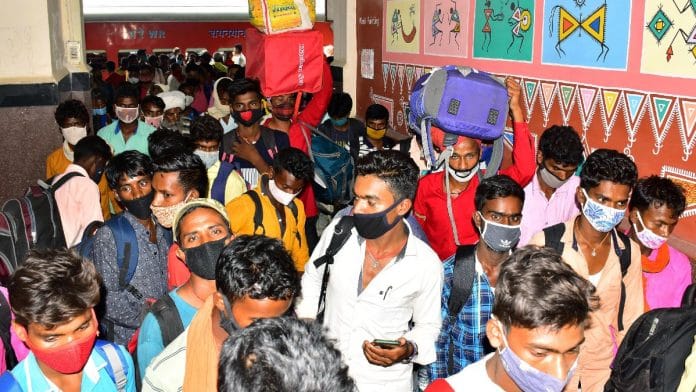Last year in Kerala, at a charming Fort Kochi restaurant, I came face to face with the story of outbound migration from Bengal. As my friend and I pored over the menu, speaking in a mix of Bengali and English, we were greeted by a young hostess—let’s call her Lata—of pleasant deportment. “Are you from Kolkata?” she asked, smiling ear to ear when we replied in the affirmative. Born in Burdwan, Lata told us about her tryst with Kolkata.
She dreamt of becoming an air hostess and trained for it. When that didn’t work out, she landed a job at a five-star hotel in Kolkata. However, her salary was so low that she couldn’t afford any rented accommodation in the city. The hotel didn’t provide her with any board and lodging, which meant a daily two-hour train commute from Burdwan. Lata took the next best option: the Kochi restaurant where she was offered not just meals and accommodation but also a significantly higher salary.
Her experience reflects West Bengal’s high out-migration rate. According to the 2011 Census, Bengal is among the top four states in India—after Uttar Pradesh, Rajasthan, and Bihar—where people leave in droves to look for jobs elsewhere. A recent report by the Economic Advisory Council of the Prime Minister (EAC-PM), attractively titled ‘400 Million Dreams’, gives West Bengal’s migration story a spin. The state is now also a top destination for inbound migration, it says.
Many are seeing this as another feather in Bengal’s cap, a sign that the state is doing so well in terms of job creation that people from elsewhere are flocking here for work. But the twist in the tale lies in the kind of migration West Bengal is seeing. Though data from NSSO surveys rank West Bengal sixth on youth unemployment, which is much better than several other states, jobs for skilled people are few and far between, and, according to economists i spoke to, relatively poorly paid. People like Lata, with education and some employable skills, were and still are leaving in hordes.
The economists also said that the legal tangle over corruption in the West Bengal School Service Commission has forced thousands of trained teachers to migrate to neighbouring Odisha, Jharkhand and Bihar for work. Many Bengali out-migrants end up doing unskilled work, which they would never do in their home state.
Those moving to West Bengal, mostly from Bihar and Jharkhand, are mostly unskilled labourers, filling the vacuum created by local Bengali workers who avoid certain manual work. Sikh taxi drivers in Kolkata, for instance, are being replaced by drivers from Bihar and Jharkhand. Bengali youth may scrape together some money and buy a taxi but won’t drive it. They will hire a Bihari to do that job. Driving a car for a living is apparently injurious to the ephemeral quality that Bengalis prize highly: prestige. It is also this prestige that gets in the way of a Bengali youth doing the job of a sweeper at, say, the Kolkata Municipal Corporation. A big disincentive came when the corporation did away with employing ‘jharudars’ full-time and made it contractual instead, an economist studying urban jobs and migration in Kolkata told me.
What drives migration?
The key issue is the factor driving migration overall. Is it the ‘pull factor’ or ‘push factor’? According to economist Everett S Lee, push factors are triggers that drive people out of their places of origin. These include limited job opportunities, calamities such as famine and drought, fear of political or religious persecution, and poor healthcare and housing. Pull factors, on the other hand, prompt people to move to other places. These include more lucrative opportunities, better housing, and healthcare.
In the case of Lata, the push factor was at play. She didn’t get a job at home and went off to Kerala. Hers is also the story of those who migrate to West Bengal to work as taxi drivers and sweepers. When the push factor drives migration, there is a lot left to be desired.
Also read:
400 Million Dreams
One of the most contentious conclusions the 400 Million Dreams report draws is that from 2011 to 2023, migration has reduced across the country by 11.8 per cent. The authors “hypothesise” that the fall in migration is “on account of availability of improved services such as education, health, infrastructure and connectivity as well as improved economic opportunities in or near in major sources of migration and is an indicator of overall economic growth.” This deduction is being questioned by many economists.
They’re not sure that’s the only way to read the data compiled by Bibek Debroy and Devi Prasad Misra. The EAC-PM report, most economists I spoke with agreed, is based on sketchy data collected from three sources: unreserved railway passenger volumes, roaming data of cell phones, and banks. They also agree on one crying need: the Census, now pending for more than three years. The decadal Census is the only way to get reliable data and one can only hope that Union Home Minister Amit Shah will stick to his promise of starting the Census process “soon”.
True data will give a reality check to Bengal. If the data for in-bound migration is indeed a real positive, then Lata of Fort Kochi, one of India’s 400 million dreamers, could return home.
Monideepa Banerjie is a senior journalist based in Kolkata. She tweets @Monideepa62. Views are personal.
(Edited by Zoya Bhatti)






